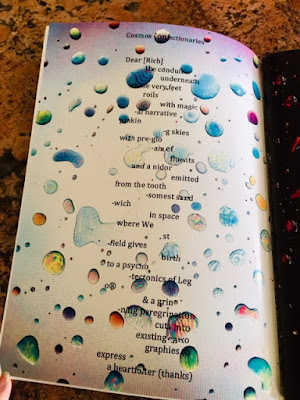EILEEN TABIOS Engages
NIDORS by Colin Lee Marshall
(Crater 52, London
and Seoul, 2018)
I open the interestingly-produced/designed chap NIDORS by Colin Lee Marshall to look
immediately at the wildfire-colored first page (chap doesn’t bother with such
tedious items as title page, copyright page, et al). I begin to read the first
poem “Purpureal Proem” that opens with the line
“for meat it is that the sun did
shone”
I read—and viewed—NIDORS
while in a U.S. state that’s currently on fire: California. And so this opening
is a bludgeoning—it brings the wildfires home with the page color and text that
looks to be melting:
The poem also contains a wild energy through such lines
as “the hero lying / atop a catafalque of own bones” as well as the bracketed
parenthetical “these deer are literally shit / -ting themselves!” The fires
outside my house walls are also decimating the deer and other wildlife…
I am relieved that the next poem lightens the tone by offering nothing less than candy:
From the shared images of the first two pages, you can
see that these are not just text-based poems but visual poetry, presented as
they are against glossy wallpapers (for some reason, “wallpaper” comes to mind
instead of just “background”). But based
on the third page facing the seemingly light “Cosmos Confections”—
—there’s more brooding ahead, e.g.
“…the night / a poultice of shit sm
/ eared …”
—from “Lautreamont Medicine Show”
“when we were young / the booze was
yellow / and diaphanous”
—from “Jeroboam for Li Po”
A book description on the chap’s back cover says NIDORS’ poems “sprang … from the rebuke”
… turning me to what “nidor” means. Merriam Webster defines it as
“a strong smell : reek
especially : the smell of cooking or burning meat or fat”
The wildfires are still a hundred miles away and yet I smell
the conflagration whenever I leave the house and breathe in the noxious
pollutants they bring to gray the local sky …
The book description also asks, “How will poetry work out
its particular roboclasm under the climate of the internet?” As someone currently exploring the
“cloudygenous” (internet-based cultures), what I see are the pathos of poets
nonetheless being located in non-robotic bodies: the flesh that still “shit”s
despite attempts to travel internet space. Because the human clings to the
internet, one can change the “white page” backing a text poem into radioactive
colors and patterns. Yet radioactivity (as it were) remains mere concept: one
needs to leave the page to be afflicted by radioactivity, … or maybe that’s why
the poet clings to the page, to its paper?
Well, it’s all legit: Poetry can take anything thrown at it.
So what if the words in some poems melt (“patrifex” and others), blur (“burial”), or
shimmer-into-illegibility (“Korean Airpithaplanium”) against these bodacious
backgrounds? Was Poetry ever just words?
I think of the burnt corpses of California’s most dangerous
wildfires so far recorded. As of this writing, the human death toll is at 31
but likely to rise as hundreds are still missing. NIDORS reminds me that the images I’m looking at in the internet
have distinct smells that fail to emanate through the computer screen. I recommend NIDORS for its colors and poems that turn readers into
philosophers, albeit those who’ve emptied or want to empty the jeroboams when considering the frailty of human flesh.
*****
Eileen Tabios is the editor of Galatea Resurrects (GR). She loves books and has released over 50 collections of poetry, fiction, essays, and experimental biographies from publishers in nine countries and cyberspace. Her 2018 poetry collections include HIRAETH: Tercets From the Last Archipelago, MURDER DEATH RESURRECTION: A Poetry Generator, TANKA: Vol. 1, and ONE TWO THREE: Selected Hay(na)ku Poems which is a bilingual English-Spanish edition with translator Rebeka Lembo. Forthcoming is WITNESS IN A CONVEX MIRROR which will inaugurate Tinfish Press' "Pacific response to John Ashbery." She also invented the poetry form “hay(na)ku” whose 15-year anniversary in 2018 is celebrated at the San Francisco and Saint Helena Public Libraries. More information about her works is available at http://eileenrtabios.com.



